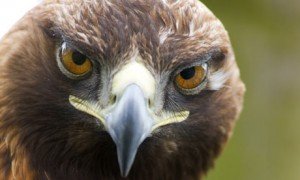
Okay, folks, today we will be discussing one of those internet pass-arounds which are meant to fill everyone with joy and inspiration, but which make wildlife rehabilitators look for the nearest wall against which to bang our heads. It’s a nice metaphor, but let’s just say it would not hold up in court. Here is the text, taken verbatim:
The eagle has the longest lifespan among birds. It can live up to 70 years. But to reach this age, the eagle must make a hard decision.
In its 40’s, its long and flexible talons can no longer grab prey which serves as food. Its long and sharp beak becomes bent. Its old-aged and heavy wings, due to their thick feathers, become stuck to its chest and make it difficult to fly.
Then the eagle is left with only two options: die, or go through a painful process of change which lasts 150 days. The process requires that the eagle fly to a mountaintop and sit on its nest. There the eagle knocks its beak against a rock until it plucks it out. Afterward, the eagle will wait for a new beak to grow back, and then it will pluck out its talons. When its new talons grow back, the eagle starts plucking its old-aged feathers out. And after five months, the eagle takes its famous flight of rebirth and lives for 30 more years.
We sometimes need to get rid of old memories, habits and other past traditions. Only freed from past burdens, can we take advantage of the present.
I hate to be the bird geek who spoils the fun, but:
1) Eagles’ talons are not flexible. I know this because I once had one imbedded in me, and “flexible” is not how I would have described it.
2) Birds of prey ALL have bent beaks. That’s why they’re birds of prey, and not woodpeckers.
3) Every year (usually) eagles molt and grow a whole new set of feathers, whether they want to or not, but it’s a gradual process. Also, it’s cold on mountaintops, which would deter any sane eagle from picking out all its feathers and hanging around naked, waiting for them to grow back.
4) Captive eagles may be susceptible to mood disorders, but wild eagles are not. They are smart birds, with healthy self-images. They have places to go and fish to catch, which would not be possible if they were to remove their own body parts. Plus: what about infection? If they really were determined to bang their own faces against a rock until their beaks fell off, wouldn’t they want to swing by the vet’s office first and pick up some antibiotics? And maybe some morphine? A down coat might be helpful, too. Woolen booties. Ear muffs. I could go on.
 5) And finally, birds are not like bears, who can put on an extra hundred pounds and chill out for five months. Eagles weigh about 12 pounds and have high metabolisms, so they need to keep up the food intake. Ten days of fasting, let alone 150, and there would be a serious problem looming.
5) And finally, birds are not like bears, who can put on an extra hundred pounds and chill out for five months. Eagles weigh about 12 pounds and have high metabolisms, so they need to keep up the food intake. Ten days of fasting, let alone 150, and there would be a serious problem looming.
Yes, sometimes we do need to get rid of old memories, habits, and traditions. But we don’t need to get rid of old beaks. Beaks endure. Talons endure. Wildlife rehabilitators endure. Beaks and talons are made of keratin, like our fingernails, and they grow, are worn down, and grow back again, just like wildlife rehabilitators.
It’s a nice story, sort of, but eagles don’t go through the process of rebirth. Just being an eagle is miraculous enough.
Second photo by Murdo Macleod













The story is ancient, certainly older than Ps 103, but the moral drawn from it here is, well, new-agey beyond tolerance.
Neat stuff, Susie!
Thanks, Rick! I think this story is older than 103 AD, but -mind-bogglingly – people continue to believe it!
Aristotle has it, even.
It must come right after the chapter about the origin of Barnacle Geese, and juts before the part about swallows hibernating in the mud.
If I hear this story on the nestcam chat tomorrow, I’m gonna be SOOOO POed!! 😉
Pat, what’s the origin of Barnacle Geese?
Laura – LOL!
in the mid-13th century, Frederick II actually imported barnacle-encrusted logs from Scandinavia to test the story.
What’s the myth about Barnacle Geese?
I looked it up, and I’m going to try to type it with a straight face – it seems at the end of the 12th century Bishop Gerald of Wales said that since Barnacle Geese came from barnacles, it was ok for churchmen to eat them during fasts. It was also a way to try to convince Jews of the immaculate conception. This is beginning to sound like a Monte Python segment, so I’m signing off.
Yes, and european otters were also fit to eat during fasts because due to their largely aquatic lifestyle they were regarded as fish. Or were they fit to eat because young otters also hatched hatch from mussles? Darn, I can’t remember. But it totally makes sense.
Shearwater chicks and fetal rabbits were also excluded from the meat category during fasts.
The medieval uncertainty about just what the bird named “bernicla” really was has lingering traces in modern taxonomy: just look quickly at the scientific name of the brant.
Branta bernicula! Look at all the stuff I’m learning!
Lepas anserifera (the barnacle in question) is named after the goose (anser) and the goose after the barnacle. Naming in Latin done by no other than Linnaeus. The mysterious appearance and disappearance made people believe this myth in the time before jet planes. Of course, nowadays we don’t have that excuse anymore.
Sigh, Peter! Humans don’t have that excuse for so many of the things we do.
Thanks Suzie. I was searching for the fact.
Thanks got this . I had actually never heard this myth before today do I wanted to look it up and “fact check”. Glad I found your article.
“Thousands of blistering barnacles” – Captain Haddock
This story is bogus! Religious horse manure. Please kill it promptly! Not based on any facts. Do not propagate it!
Had to Google about this story immediately as it just sounded full of foolish things… It didn’t seem scientific in the least. Thanks for debunking this story!
HINDU..NOT CHRISTIAN
INDIA NOT ‘MidEast’ and
The story is ANALOGOUS..
AS with many analagies, it served a “teaching lesson”
Taking various seasons into one “rebirth”.. poetic but not text nor scriptural based.
The truth is EVEN better!! I like the story and use to to teach about the importance of going through pain in order to grow and extend your life…BUT this is much better! Eagles naturally take care of their beaks and talons by eating tough prey and sharpening them on rocks…and the feathers naturally molt…it teaches us the importance of not getting comfortable too much but learning how to stay sharp in life
I’m going to teach this story with the tag that “bird people” denounce it. They have facts that say it can’t be true. So how do we marry it with the verse in Psalms 103? I believe I know
On Dec 17, 2023 went on a mangrove tour in Langkawi, Malaysia. Part of the tour included a stop at an eagle feeding area. The guide told us that eagles go through two life changes when they lose all their feathers and break off their beak on a rock. Sounded suspicious so I searched online and found your site among others that refute this myth. Perhaps if any birders or biologists head to Langkawi they can inform the guides of the truth. I asked the guide if he had studied biology and he said no. All the knowledge he had was gained on the job and searching on the internet.
Suzie,
You forgot to refute one other major part of that story, Eagles do not live to 70 years old.
Had a great laugh at the spot on the page allocated for “Band Head Here”
Interested in what other animals go
Through these “mid-life” crisis.